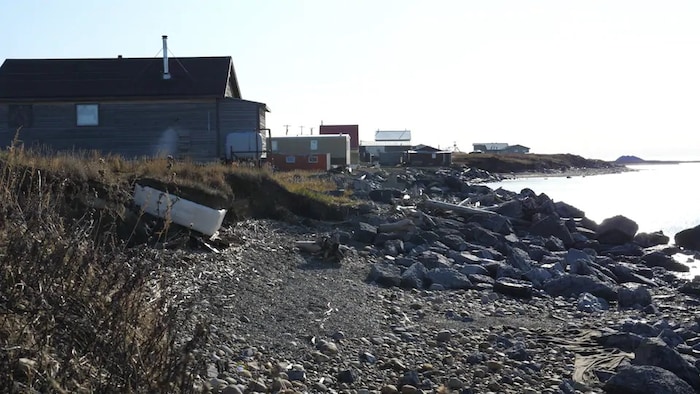Open full screen Tuktoyaktuk, near the Arctic Ocean, is threatened by coastal erosion.< /p>Radio-Canada Voice synthesis, based on artificial intelligence, makes it possible to generate spoken text from a written text. Coastal erosion and thawing permafrost threaten archaeological sites important to communities in the Northwest Territories, and are the subject of increased monitoring. Territory archaeologist Michael O'Rourke is working with communities to mitigate the effects of climate change at approximately 45 significant archaeological sites in the NWT.
Michael O'Rourke is an archaeologist for the Government of the Northwest Territories.
Climate change has many impacts. Coastal erosion is one that is major, because its effects are quite rapid, he said, adding that this erosion is particularly visible in the Beaufort Delta region.
In some areas, the coast is eroding at a rate of five to ten meters per year, according to the archaeologist.
The thawing of permafrost is, according to him, more insidious. Archaeological sites in the Northwest Territories, well preserved in permafrost, are exposed to more oxygen, water and bacteria when it thaws, [which] actually disintegrates much more quickly.
< p class="StyledBodyHtmlParagraph-sc-48221190-4 hnvfyV">O'Rourke says there are about 7,000 archaeological sites in the NWT, but there could be many more yet undiscovered , which are also threatened.
Archival aerial photos and satellite images are used to monitor the condition of the 45 significant sites. These images allow us to create models of coastal erosion.
It allows us to go into communities and discuss next steps, x27;There's anything we should do, he adds.
But mitigating the effects of climate change is not always wanted by communities.
Some people want nature to take its course and I don't I don't want to be the person who says we have to protect these archaeological sites at all costs.
Mitigation can take different forms, if is desired by the community, according to Mr. O'Rourke.
Archaeologists can visit these sites in the company of elders and young people from the community, to share their knowledge. We can take the opportunity to talk about the past and document the elders' perspective on the way of life [at the time of] these sites, while they are still in the ground.
Tuktoyaktuk, near the Arctic Ocean, in the Territories of Northwest.
In Tuktoyaktuk, former mayor Darrel Nasogaluak, a member of the local hunters and fishermen association, supported archaeologist O'Rourke in identifying threatened sites in his community.
There are many many sites here. Our people lived on the territory. The communities weren't big, he said.
Darrel Nasogaluak, former mayor of Tuktoyaktuk, says there are many sites in his area.
We traveled our territory all seasons, so there are places that we traditionally used every 5 km, where we spent a lot of time. Many of these traditional camps or small villages are located on the coastline. Some are being eroded, says Darrel Nasogaluak.
Oral tradition is very strong here, so we know where all the newer villages are, going back as far as two hundred years. Beyond that, these are stories that have been passed down to us.
A quote from Darrel Nasogaluak, former mayor of Tuktoyaktuk
Darrel Nasogaluak says the community praises the preservation efforts. We're still learning about the evolution of our culture, he says.
With information from Hilary Bird< /em>

